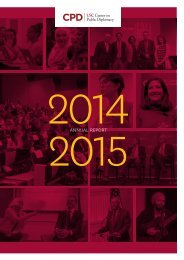You also want an ePaper? Increase the reach of your titles
YUMPU automatically turns print PDFs into web optimized ePapers that Google loves.
PUBLIC DIPLOMACY IN SUB-SAHARAN <strong>AFRICA</strong><br />
and amateurs – to engage in video film<br />
productions. Now, other African countries<br />
are emulating Nnebue in making movies in<br />
video format.<br />
New technologies, such as video<br />
technology, have provided the Nigerian film<br />
industry with the tools to engage in cultural<br />
diplomacy, including interactions between<br />
various Nigerian and other African ethnic<br />
and cultural groups. Nollywood portrays<br />
Africa both in positive and negative ways.<br />
Nonetheless, one of the most important<br />
things is that the proliferation of video<br />
technology has made it possible for the Igbo<br />
and Africans in general to tell their own<br />
stories.<br />
Right now, making Nollywood movies<br />
has been transforming from videocassettes,<br />
to analog video, and to digital equipment.<br />
The Nigerian forms of film production<br />
have been tagged “home video,” “video,”<br />
and “video film.” The term "video film" is<br />
the outcome of combining television and<br />
cinema. 18 Expanding Haynes’s definition,<br />
Onuzulike articulates the term “video<br />
film” as “any movie or motion picture<br />
produced mainly in video format while<br />
adhering to particular cinematic values<br />
and conventions.” 19 However, Nollywood<br />
has produced movies on celluloid including<br />
The Amazing Grace (2006) 20 and Half of a<br />
Yellow Sun (2013). 21 Due to the high cost<br />
of celluloid, Nigerian filmmakers resort to<br />
video.<br />
Although dated, a 2006 survey<br />
conducted by the UNESCO Institute for<br />
Statistics (UIS) ranked Nollywood as the<br />
second-largest film producer in the world,<br />
just behind Bollywood. Hollywood was<br />
placed third. The survey accounted that<br />
Bollywood produced 1,091 feature length<br />
films, Nollywood made 872 (all in video<br />
format) while Hollywood made 485 major<br />
film productions. 22<br />
Due to the Igbo entrepreneurial<br />
quest, “the video film phenomenon has<br />
created an environment in which [Igbo],<br />
Nigerian and other African cultural contexts<br />
can be reproduced.” 23 “Video film has<br />
transformed how contemporary African<br />
filmmakers tell their stories.” 24 The Igbo<br />
oral communication and material culture<br />
are ever-present in both in Igbo-language<br />
and English version movies. Some of the<br />
facets are attire, artifacts, proverbs, idioms,<br />
and Igbo sound bites. Igbo proverbs are not<br />
only vital to the propagation of Igbo culture<br />
in all its implications; they are a factor in<br />
formal and familiar speeches and in other<br />
forms of popular communication.<br />
The almost compulsory use of<br />
Igbo idioms (akpaalaokwu), proverbs (ilu),<br />
and parables (ukabuilu) “has elevated the<br />
language to the status of a living art of<br />
popular communication.”25 In the Igbo<br />
traditional setting, when people come to<br />
talk, especially about important issues,<br />
they use idioms, proverbs, and other forms<br />
of expression to introduce or explain their<br />
matters. Often, the speakers expect the<br />
listener to understand these forms of speech<br />
without being explicit.26<br />
THE IGBO IMPACT ON<br />
NOLLYWOOD<br />
Igbo-language films and Igbo<br />
English movies help advance Igbo across<br />
Africa and beyond. Igbo film productions<br />
help provide inter-ethnic and inter-cultural<br />
communication. For example, different<br />
ethnic and cultural groups appear on the<br />
set at the same time. They work together<br />
producing movies and it increases their<br />
inter-ethnic and inter-cultural competency.<br />
Two of the most prominent<br />
Nollywood films, Living in Bondage (1992)<br />
and Osuofia in London (2003/2004), are based<br />
on Igbo culture and people. As indicated<br />
earlier, Living in Bondage is credited by<br />
many as the film that made the Nigerian<br />
film industry successful. Osuofia in London is<br />
arguably the most popular Nollywood movie<br />
ever made. 27 Many Nollywood audiences<br />
are familiar with Osuofia in London, one of<br />
the most popular Nollywood films, and<br />
can relate to it. Even though the film was<br />
made in English, it is full of Igbo aesthetics,<br />
culture, and sound bites. The film was shot<br />
in Nigeria and in London representing the<br />
transnational lives of the Igbo. Igbo culture<br />
is manifested in their language, mode of<br />
dress, food, belief system, norms and value<br />
system, etc. Many people of African descent<br />
that are familiar with Nollywood movies<br />
tend to imitate the Igbo cultural cues that<br />
are common in them.<br />
Igbo culture encompasses religious<br />
objects; art, artifacts, and symbols; music<br />
and dance; proverbs, idioms, riddles, and<br />
CULTURE PUBLIC-PRIVATE GOVERNMENT<br />
41 WINTER 2016 | @PD_Mag<br />
WINTER 2016 | @PD_Mag 42



